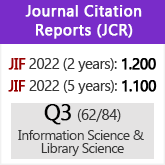Visualization systems for digital libraries
DOI:
https://doi.org/10.3989/redc.2005.v28.i3.170Keywords:
digital libraries, information visualization systems, information retrieval systemsAbstract
The conventional functions of a library are to gather, process, broadcast, store and use the documental information to provide service to the society. And this definition can also be applied in the context of the digital age, where the work of the professionals of the information and documentation is daily related to the use of the available resources through Internet. Although the definition of Digital Library includes a wider term, the present article it will refer to the group of digital resources. Internet is the biggest encyclopedia in the world, but the information is not available in an orderly way and it is not easy to obtain. Although the users, librarians and documentalists have tools as search engines to locate the information, the way we obtain the results is decisive in order to their suitable exploitation. The traditional orderly list of references can loose its effectiveness when the number of obtained documents is very high. In this article, we show several available techniques and developments on visualization systems in the information retrieval in Internet. These systems use elements in two or three dimensions, and it will allow that users, librarians and documentalists have the feeling of moving among the recovered information as they would do in a surface or in the space.
Downloads
Download data is not yet available.
Downloads
Published
2005-09-30
How to Cite
Bengochea, L., & Patricio, M. Ángel. (2005). Visualization systems for digital libraries. Revista Española De Documentación Científica, 28(3), 273–292. https://doi.org/10.3989/redc.2005.v28.i3.170
Issue
Section
Studies
License
Copyright (c) 2005 Consejo Superior de Investigaciones Científicas (CSIC)

This work is licensed under a Creative Commons Attribution 4.0 International License.
© CSIC. Manuscripts published in both the printed and online versions of this Journal are the property of Consejo Superior de Investigaciones Científicas, and quoting this source is a requirement for any partial or full reproduction.All contents of this electronic edition, except where otherwise noted, are distributed under a “Creative Commons Attribution 4.0 International” (CC BY 4.0) License. You may read here the basic information and the legal text of the license. The indication of the CC BY 4.0 License must be expressly stated in this way when necessary.
Self-archiving in repositories, personal webpages or similar, of any version other than the published by the Editor, is not allowed.

















